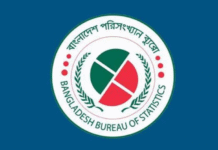The government’s increased efforts to clear overdue foreign payments and the tactics of aggregator exchange houses have driven the remittance dollar rate to an all-time high of Tk127, signalling heightened economic headwinds.
Senior officials from six banks reported paying Tk126.50-Tk127 on Wednesday to secure remittance dollars, the highest rate in the country’s history. This surpasses the previous record of Tk126 in November 2023. After fluctuating for some time, the rate has sharply risen since early December.
According to a deputy managing director of a private bank, the remittance dollar rate stood at Tk121.80 in early November and climbed to Tk122.50 by the month’s end.
“However, within just 13 working days of December, the rate surged by Tk4.50 or 3.67%, an increase described as unusual from any perspective,” he added.
“This level of price increase is unusual from any perspective,” the official said. “While dollar demand in the market has risen slightly, it does not justify such a sharp price hike.”

The treasury heads of several private banks said such an unusual rise in the dollar rate will put significant pressure on the economy, ultimately fuelling the already high inflation.
A deputy managing director of a private bank explained, “Aggregators often commit to a fixed rate in the morning but later retract, citing higher offers from other banks. This disrupts our payment schedules.”
A dollar market aggregator is a financial intermediary that connects buyers and sellers of dollars. They often aggregate liquidity from multiple sources to provide competitive exchange rates to their clients. Well-known examples include Western Union, Xoom, Remitly, MoneyGram, and CurrencyFair.
An unscheduled meeting involving a deputy governor of the central bank and policymakers from 11 banks discussed these issues, but no concrete resolutions were made.
Syed Mahbubur Rahman, managing director of Mutual Trust Bank, said, “The demand for dollars in banks has increased slightly, making a moderate rise in rates natural. However, the sharp increase in December is inconsistent with market demand and may affect inflation control efforts.”
Managing directors of several leading private banks have identified key reasons behind the recent surge in remittance dollar rates.
First, they point to a slight increase in dollar demand in the market. From September to January, import payment deadlines contribute to heightened demand, with December experiencing the most pressure. When dollar demand surpasses supply, the exchange rate rises.
Second, aggregator exchange houses have been flagged as major contributors to the excessive price hike over the past two weeks.
These aggregators purchase dollars from smaller exchange houses at slightly lower rates early in the day, consolidating remittance dollars into the hands of 7-8 large players.
These aggregators then sell dollars to banks through an auction-like process, where banks willing to offer the highest rates secure the dollars. This practice inflates the dollar rate and allows aggregators to maximise profits.
Third, since the interim government assumed office, the central bank has significantly reduced dollar sales from reserves and, instead, has begun purchasing small amounts from the market.
Fourth, the IMF is pressuring the central bank to adopt a crawling peg system for determining the dollar rate. This has led to speculation among banks and customers that the central bank might fully liberalise the dollar market under the crawling peg system, potentially causing further dollar price increases.
Fifth, state banks have emerged as new competitors in the remittance dollar market to address their overdue payment obligations, which have accumulated significantly. To clear these payments, they are actively buying dollars, a trend unseen in the past two years. Currently, these banks account for 50% of dollar purchases in the remittance market.
Surge in remittance inflows
During July-November of the current fiscal year, remittance inflow through formal channels increased by 26.44%, rising from $8.81 billion to $11.14 billion year-over-year. According to central bank data, remittances to the banking sector grew by $2.34 billion, all absorbed by state-owned banks.
The five public banks – Agrani, Janata, Rupali, Sonali, and Krishi – received $3.42 billion in remittances during this period, a 217% increase from the $1.08 billion received in the same period last year. Rupali Bank recorded the highest growth at 1343%, with the others also exceeding 100% growth.
Private banks, however, are struggling due to unethical practices by aggregator exchange houses, say bankers.
Dollar hits Tk127.50 in kerb market
The soaring dollar rate in the banking channel has led to a severe cash dollar shortage in the kerb market. Exchange houses in Motijheel, Paltan, Baitul Mukarram, and Gulshan saw many buyers return empty-handed due to high prices.
The dollar sold for up to Tk127.50 in the kerb market yesterday. While many exchange houses offered a maximum buying rate of Tk127, dollars were largely unavailable.
Abbas, a customer at a Gulshan exchange house, expressed frustration, “A week ago, dollars were available at Tk124. Now it’s Tk127, and I couldn’t buy any despite visiting several exchange houses.”
The hike also impacted other currencies. Nayan, recently back from China, said, “I bought Chinese yuan for Tk17 ten days ago, but today I sold it for Tk17.50.”
Ali Akbar of Sugandha Exchange House highlighted the unusual demand: “Last week, I sold dollars for Tk124. Today, a few buyers urgently needed them and paid Tk127.50. Even sellers like us couldn’t find dollars at Tk127.”
Explaining the shortage, Akbar noted that while remittances through banking channels have increased, cash dollar inflows in the open market have not. He added, “With reduced travel to India, fewer dollars are entering the country through the Indian border, affecting cash supply.”
Murad, another seller, pointed out the disparity between market and official rates, “The Money Changers Association of Bangladesh set the dollar rate at Tk120, but we couldn’t buy even at Tk126.50. How can we sell at the official rate?”
The kerb market crisis highlights the broader challenges in stabilizing dollar rates amidst rising pressures in the banking and remittance markets.
tbs









